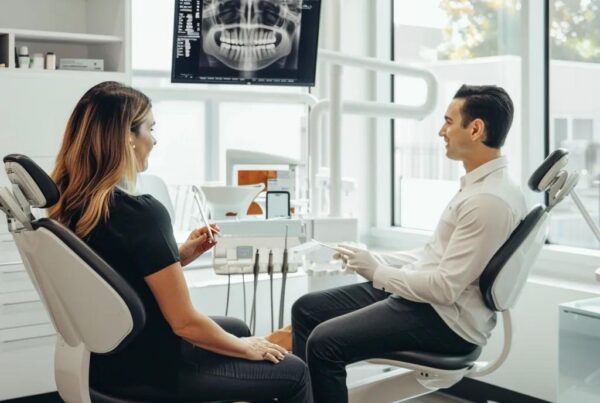An emergency root canal isn’t just another dental appointment, it’s your tooth’s last chance at survival. When you’re dealing with excruciating pain that makes it impossible to sleep, eat, or think straight, this procedure becomes a lifeline that can save your natural tooth.
The thing about emergency root canals is they happen when your tooth is in serious trouble. We’re talking about infections deep inside the tooth or injuries that have damaged the nerve beyond repair. This isn’t the kind of discomfort you can tough out with some ibuprofen and hope it goes away.
You’ll know you need one when you see visible signs like swelling, abscesses, or that telltale throbbing pain that seems to have a heartbeat of its own. These are your tooth’s way of sending an SOS signal that something is seriously wrong inside.
At Fountain of Youth Dental, we understand that dental emergencies don’t follow business hours. When you’re in that kind of pain, every minute feels like an hour, and we’re committed to getting you the relief you need as quickly as possible.
Why Emergency Root Canals Save More Than Just Your Tooth
Emergency root canal treatments serve three crucial purposes that go way beyond just fixing a painful tooth. They’re about preserving your smile, protecting your health, and preventing a small problem from becoming a major medical issue.
First, there’s the immediate relief from that intense, debilitating pain that brought you to our office in the first place. This isn’t just discomfort, it’s the kind of nerve pain that can make even the strongest person feel helpless. The procedure removes the damaged nerve tissue that’s causing all that agony.
Then there’s the tooth-saving aspect that people don’t always think about. Without emergency treatment, you’re looking at losing that tooth entirely. Once it’s gone, you’re dealing with gaps in your smile, chewing problems, and the need for more expensive replacement options like implants or bridges.
The most serious reason is preventing the spread of infection throughout your body. What starts as a tooth problem can become a life-threatening condition if bacteria enter your bloodstream. We’ve seen infections spread to the jaw, neck, and even the heart when left untreated.
At Fountain of Youth Dental in San Antonio, we’ve handled countless emergency situations, and we know how quickly things can escalate when treatment is delayed. Acting fast isn’t just about comfort, it’s about protecting your overall health.
The Truth About Root Canal Pain
Let’s clear up the biggest myth about root canals right now, the procedure itself doesn’t cause pain, it eliminates it. Most of the horror stories you’ve heard come from people who experienced the infection pain before treatment, not during the actual procedure.
Here’s what actually happens: we numb the area completely before starting anything. Modern anesthesia is incredibly effective, so you shouldn’t feel any discomfort during the procedure. The most you might experience is some pressure as we work, but no sharp pain.
The real pain comes from that infected or damaged pulp inside your tooth. Once we remove that source of infection and inflammation, the intense pain you’ve been dealing with starts to subside. Most patients tell us they feel relief almost immediately after treatment.
We take patient comfort seriously at our San Antonio office. If you’re feeling anxious about the procedure, we’ll talk you through every step and make sure you’re completely comfortable before we begin. Our goal is to make this as stress-free as possible during an already difficult time.
Taking Care of Your Tooth After Emergency Treatment
What you do after your emergency root canal is just as important as the procedure itself. Good aftercare can mean the difference between a tooth that lasts for decades and one that gives you problems down the road.
The first 24-48 hours are crucial for healing. You’ll want to stick to soft foods and avoid chewing on the treated side until any temporary filling is replaced with a permanent restoration. Think soups, yogurt, and smoothies rather than crunchy or chewy foods.
Pain management during recovery is usually pretty straightforward. Most people find that over-the-counter pain relievers are enough to handle any lingering discomfort. The key is staying ahead of the pain by taking medication as directed, even if you’re feeling okay.
Keeping the area clean is essential for preventing new infections. We’ll give you specific instructions about brushing and flossing around the treated tooth. It might feel tender at first, but gentle cleaning helps ensure proper healing.
You’ll also want to avoid some habits temporarily, like smoking or drinking through straws, which can interfere with healing. These might seem like small things, but they can make a big difference in how well you recover.
How We Handle Dental Emergencies
When you’re dealing with a dental emergency, the last thing you want is to feel rushed or confused about what’s happening. That’s why we’ve developed a systematic approach that prioritizes your comfort while ensuring you get the best possible care.
Our emergency protocols are designed to get you seen quickly when you’re in serious pain. We understand that dental emergencies don’t wait for convenient times, and we do everything possible to accommodate urgent situations.
Communication is huge during emergency treatments. We explain what we’re finding, what needs to be done, and what you can expect during recovery. Nobody likes surprises when they’re already stressed about a dental problem.
The following elements make our emergency care effective:
- Rapid assessment to determine the extent of the problem and the best treatment approach
- Advanced pain management techniques to keep you comfortable throughout the procedure
- Clear explanations of what’s happening and what comes next in your treatment
- Comprehensive aftercare instructions to ensure smooth healing and prevent complications
We also make sure you know how to reach us if you have concerns during your recovery. Dental emergencies can be scary, and knowing you have support makes a huge difference in how you feel about the whole experience.
Follow-up care is built into our emergency treatment process. We’ll schedule a check-up to make sure everything is healing properly and discuss any additional treatment that might be needed, like placing a crown to protect the treated tooth.

Recognizing When You Need Emergency Care
Knowing the difference between regular tooth pain and a true dental emergency can save your tooth and potentially your life. Some symptoms are clear red flags that mean you need to call us right away, not wait until Monday morning.
Severe, spontaneous pain that wakes you up at night or makes it impossible to concentrate is a major warning sign. This isn’t the kind of sensitivity you get from cold drinks, it’s constant, throbbing pain that doesn’t respond to over-the-counter pain relievers.
Swelling in your face, gums, or neck area is another serious sign that shouldn’t be ignored. This often indicates an infection that’s spreading beyond the tooth, which can become dangerous quickly if not treated.
Fever along with tooth pain is your body’s way of telling you there’s a significant infection present. This combination of symptoms means bacteria may be entering your bloodstream, which requires immediate medical attention.
Other warning signs include pus around a tooth, a bad taste in your mouth that won’t go away, or extreme sensitivity to hot and cold that lingers long after the stimulus is removed. If you’re experiencing any of these symptoms, don’t wait to see if they improve on their own.
Your Recovery Roadmap
Recovery from an emergency root canal is usually much easier than people expect, especially when you know what to expect and follow some basic guidelines. Most patients are surprised at how quickly they start feeling better.
The detailed aftercare instructions we provide aren’t just suggestions; they’re your roadmap to successful healing. These cover everything from what to eat and drink to how to manage any discomfort you might experience.
Proper oral hygiene becomes even more important after root canal treatment. We’ll show you how to clean around the treated tooth without irritating the healing tissues. It’s a balance between keeping things clean and being gentle with the area.
Here’s what helps ensure the best recovery:
- Take prescribed antibiotics exactly as directed to prevent infection
- Use ice packs for the first 24 hours to reduce swelling and discomfort
- Stick to room temperature, soft foods until permanent restoration is placed
- Avoid smoking, alcohol, and strenuous activity for at least 24-48 hours
Most people can return to normal activities within a day or two, though you’ll want to be careful about what you eat until you get your permanent filling or crown. The temporary restoration that’s placed immediately after treatment needs protection.
We encourage patients to call with any questions or concerns during recovery. It’s better to check in with us about something minor than to worry unnecessarily or let a small problem become a bigger one.
Preventing Future Dental Emergencies
While not every dental emergency can be prevented, many of the situations that lead to emergency root canals are completely avoidable with good oral hygiene and regular dental care.
Regular checkups every six months allow us to catch small problems before they become big emergencies. A small cavity that’s caught early needs just a simple filling, but the same cavity left untreated can eventually require emergency root canal treatment.
Daily brushing and flossing remove the bacteria that cause tooth decay and gum disease. It sounds simple, but consistent oral hygiene is your best defense against most dental problems that could turn into emergencies.
Paying attention to early warning signs and not ignoring minor dental symptoms can prevent many emergency situations. Things like sensitivity to sweets, minor toothaches, or slight gum swelling are often early signs of problems that can be treated easily if caught early.
Your Emergency Dental Care Team
When dental emergencies strike, you want a team that knows how to handle urgent situations with skill and compassion. At Fountain of Youth Dental in San Antonio, we’ve built our practice around providing excellent emergency care alongside our regular dental services.
We understand that needing emergency dental treatment can be stressful and frightening. Our approach focuses on getting you comfortable, out of pain, and back to your normal life as quickly as possible. Schedule your appointment today.
Frequently Asked Questions
Will an emergency root canal procedure be painful?
No way! Emergency root canals are designed to eliminate severe tooth pain, not cause it. We use effective local anesthesia to make sure you’re completely comfortable during the procedure. Most patients are amazed at how much better they feel afterward.
How do I know if I need an emergency root canal?
If you’re dealing with intense, constant tooth pain, serious swelling, or fever along with dental symptoms, those are strong signals you need emergency care. Don’t try to tough it out, these symptoms mean there’s likely a serious infection that needs immediate treatment.
What can I expect after an emergency root canal?
You should feel significant pain relief pretty quickly after treatment. We’ll give you detailed instructions for taking care of yourself at home, and most people find recovery is much easier than they expected. The key is following the aftercare guidelines we provide.
Contact Fountain of Youth Dental today to schedule your consultation with Dr. Cappetta. With Fountain of Youth Dental, you can stop settling and finally get the healthy, stunning smile you deserve!
See More Reviews From Fountain of Youth Dental. View information about local places in our community.
Schedule Your Free Consultation Today!
Fountain of Youth Dental
5282 Medical Dr. #520 San Antonio, TX 78229 (210) 614-5481 Driving Directions
Related Articles
- Dental Implants
- Dental Implant Success
- Types of Dental Implants
- Are You a Candidate for Dental Implants?
- Dental Implant Complications
- Implants Maintenance Tips
- Same-Day Dental Implants
- Affordable teeth implants
- Dental implants surgery
- Dentures with implants
- Full Mouth Dental Implants
- Mini Dental Implants
- Zirconia Dental Implants
- Soft Tissue Grafts or “Gum Grafts”





